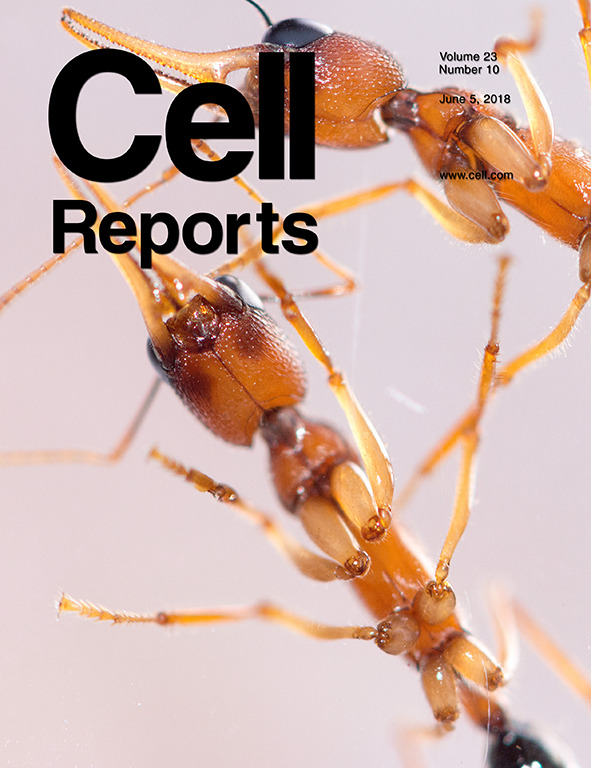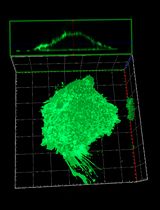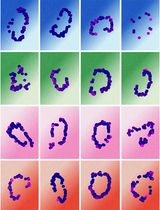- EN - English
- CN - 中文
Quantitative Determination of Primary Cilia Protein Distribution Using Immunofluorescence Staining and MATLAB Analysis
使用免疫荧光染色和 MATLAB 分析定量测定初级纤毛蛋白分布
发布: 2021年12月05日第11卷第23期 DOI: 10.21769/BioProtoc.4248 浏览次数: 3779
评审: Khyati Hitesh ShahFRANCESC GARCIA-GONZALOAnonymous reviewer(s)
Abstract
Primary cilia are microtubule-based sensory organelles surrounded by membrane. They can detect mechanical and chemical stimuli. The last few years have uncovered cilia as unique signaling hubs that host a number of receptors and effector molecules. Thus, defining how specific proteins localize and are distributed along the cilium is critical to understanding its function.
Quantitative immunofluorescence can be used to accurately assess the localization of receptors and signaling molecules within the primary cilia. However, image analysis can be time consuming, and there are limited programs that can accurately determine staining intensity along the cilia. To overcome these issues, we developed a series of MATLAB scripts to accurately measure staining intensity along the length of the cilia, in both a semi-automated and automated fashion. Here, we describe the scripts and include a protocol for image analysis for each. With these scripts, the protocols can be used to analyze the distribution of any ciliary protein using immunofluorescence images.
Background
Primary cilia are microtubule-based sensory organelles that function as antenna-like structures emerging from the cell body. They detect mechanical and chemical signals from the environment and are involved in a range of biological processes critical for homeostasis (Goetz and Anderson, 2010; Anvarian et al., 2019). Not surprisingly, genetic cilia defects result in various clinical manifestations, called ciliopathies (Goetz and Anderson, 2010). Interestingly, the ciliary membrane hosts unique receptors and effector molecules that control a number of signaling pathways and biological processes. These include oncogenic receptor tyrosine kinases (RTKs), such as insulin-like growth factor receptor (IGF-1R) or platelet-derived growth factor receptor alpha (PDGFR-α), and G-protein coupled receptors (GPCRs), such as smoothened (SMO) (Christensen et al., 2012; Schou et al., 2015).
We previously reported that primary cilia mediate resistance to several kinase inhibitors in cancer cells (Jenks et al., 2018). Drug resistant cells show more cilia, longer cilia, the appearance of cilia terminal fragments (CTF), and increased activation of the cilia-specific Hedgehog signaling pathway (Jenks et al., 2018). Significantly, targeting cilia or ciliary signaling can sensitize drug-resistant cells to their respective inhibitors (Jenks et al., 2018). Interestingly, drug resistant cells show changes in the distribution of cilia proteins, including Kif7 and IFT81. While control cells showed Kif7 and IFT81 distributed along the cilia and at the cilia tip, drug resistant cells showed a significant decrease in the distribution of these proteins along the cilia (Jenks et al., 2018). In addition, we observed changes in a number of proteins and ciliary receptors in drug resistant cells, highlighting the importance of developing accurate image analysis tools for cilia research.
These results presented us with the challenge of being able to measure the distribution of proteins along the cilium. The accurate quantification of fluorescence intensity in microscopy images is an important part of cilia research. For this purpose, two open source software packages have been described (Lauring et al., 2019; Hansen et al., 2021). To accurately quantify the distribution of proteins along the cilia, we developed a series of MATLAB scripts that support cilia analysis using the improfile function of MATLAB and adaptive threshold for binarization. Our protocols are versatile, intuitive, and start with a manual script that is then fully automated. As cilia and cilia staining can be heterogeneous, our automated protocol can be adapted to different conditions by changing the pixel intensity threshold, named “level” in the script. These scripts are outlined here, along with a detailed step-by-step guide to use them with examples. A supplementary section with each script is included.
Materials and Reagents
12 mm round coverslips (Fisher Scientific, catalog number: 11846933)
6-well plates (Corning, catalog number: 353046)
16% Formaldehyde (Thermo Fisher Scientific, catalog number: 28908)
NaCl (VWR International, catalog number: 10241)
KCl (VWR International, catalog number: 10198)
KH2PO4 (VWR International, catalog number: 10203)
Na2HPO4 (VWR International, catalog number: 10249)
HCl (VWR International, catalog number: 45002)
Triton-X-100 (Sigma-Aldrich, catalog number: T8787)
Bovine Serum Albumin (BSA) (Sigma-Aldrich, catalog number: A7906)
4′,6-Diamidine-2′-phenylindole dihydrochloride (DAPI) (Thermo Fisher Scientific, catalog number: D1306)
Methanol (VWR International, catalog number: 20847.318)
Prolong Gold Mounting Media (Thermo Fisher Scientific catalog number: P10144)
Superfrost adhesion slides (Thermo Fisher Scientific, catalog number: 10149870)
Poly-L-lysine (Sigma-Aldrich, catalog number: P6282)
PTEM Buffer (see Recipes)
1× Phosphate Buffered Saline (1× PBS) (see Recipes)
1× PBST (see Recipes)
1× PBSBT (see Recipes)
Primary antibodies: mouse anti-acetylated tubulin (1:2,000 dilution; Sigma-Aldrich, catalog number: T7451)
Mouse anti-γ-tubulin (1:500 dilution; Santa Cruz, catalog number: sc-51715)
Rabbit anti-IFT81 antibody (1:200 dilution; Proteintech, catalog number: 17744-1-AP)
Rabbit anti-Arl13B (1:500; Proteintech, catalog number: 17711-1-AP)
Secondary antibodies: Alexa Fluor 488 (Thermo Fisher Scientific, catalog number: A-21141), 594 (Thermo Fisher Scientific, catalog number: A11037), or 680 (Thermo Fisher Scientific, catalog number: A31562) (1:500 dilution)
Cell lines
A204 and RPE-1 cell lines were used as indicated. Cells were grown in Dulbecco’s Modified Eagle Medium (DMEM) and Dulbecco’s Modified Eagle Medium: Nutrient Mixture F-12 (DMEM:F12) media with 10% FBS, respectively.
Equipment
Orbital shaker
Epifluorescence microscope: Upright microscope (Axio Imager M2; Zeiss) equipped with 100× oil objectives, 1.4 numerical aperture (N.A.), a camera (ORCA R2; Hamamatsu Photonics), and a computer with image-processing software (Zen)
Zeiss 710 confocal microscope with Zen software
Computer specifications: To run MATLAB – Intel or AMD x86-64 processor with four logical cores and AVX2, 8 GB RAM, Windows 7 or newer operating system
Software
Mathworks MATLAB (version R2020b) with the image processing toolbox
Excel (Microsoft)
Zen (Zeiss image acquisition software)
Procedure
文章信息
版权信息
© 2021 The Authors; exclusive licensee Bio-protocol LLC.
如何引用
Jenks, A. D., Fivaz, M. and Tanos, B. E. (2021). Quantitative Determination of Primary Cilia Protein Distribution Using Immunofluorescence Staining and MATLAB Analysis. Bio-protocol 11(23): e4248. DOI: 10.21769/BioProtoc.4248.
分类
细胞生物学 > 细胞成像 > 荧光
生物科学 > 生物技术
您对这篇实验方法有问题吗?
在此处发布您的问题,我们将邀请本文作者来回答。同时,我们会将您的问题发布到Bio-protocol Exchange,以便寻求社区成员的帮助。
提问指南
+ 问题描述
写下详细的问题描述,包括所有有助于他人回答您问题的信息(例如实验过程、条件和相关图像等)。
Share
Bluesky
X
Copy link












